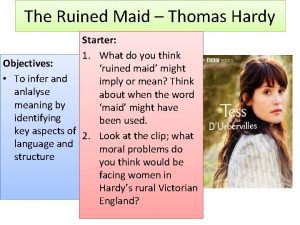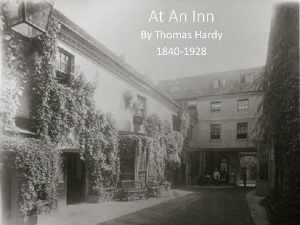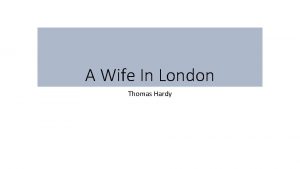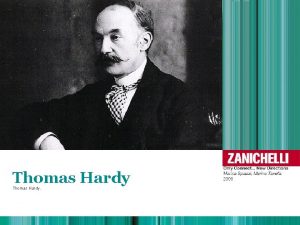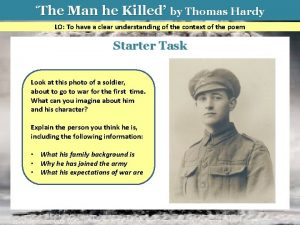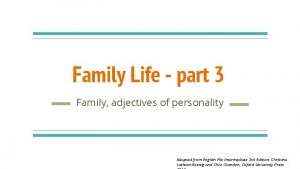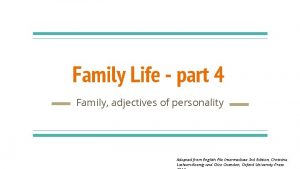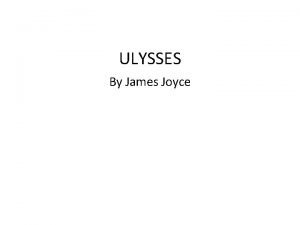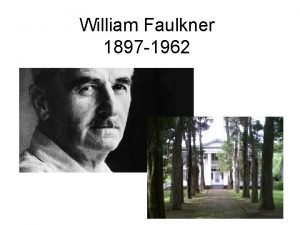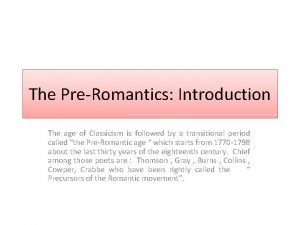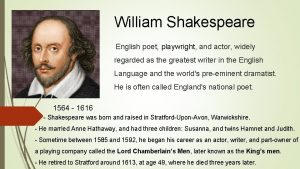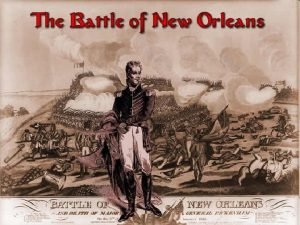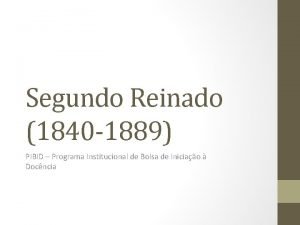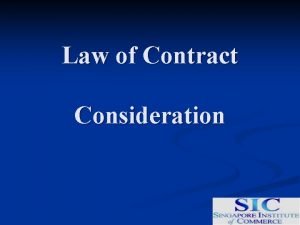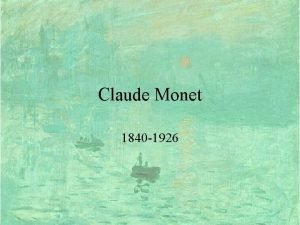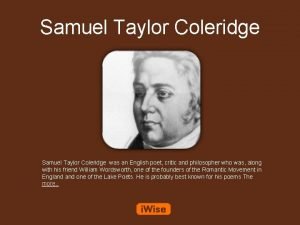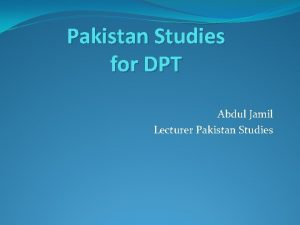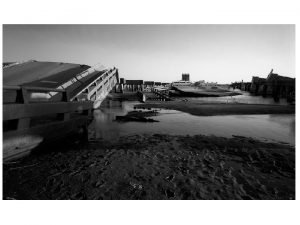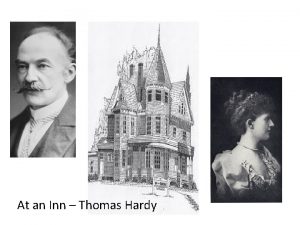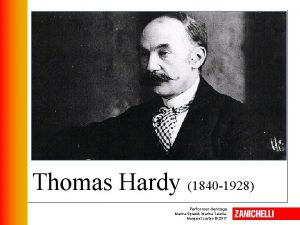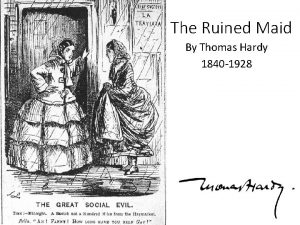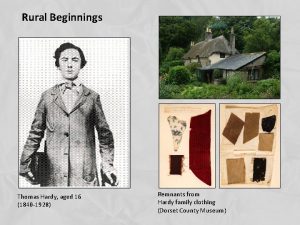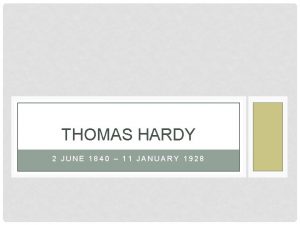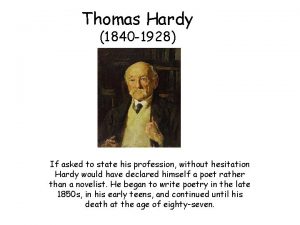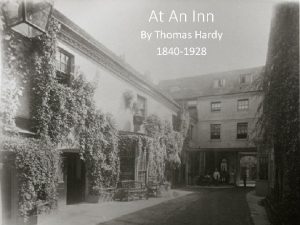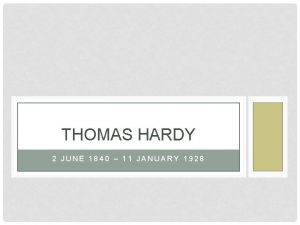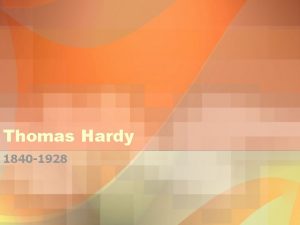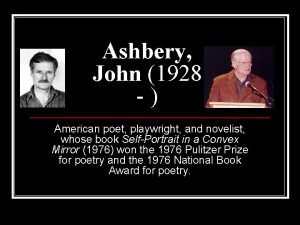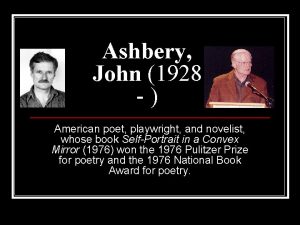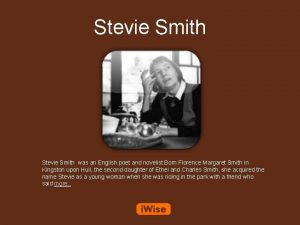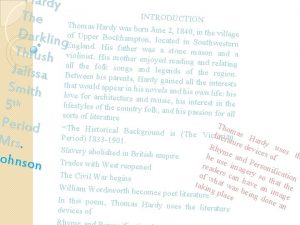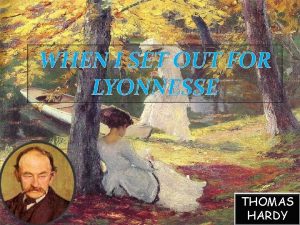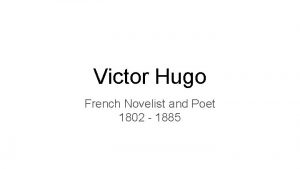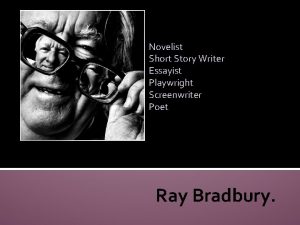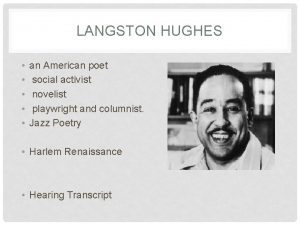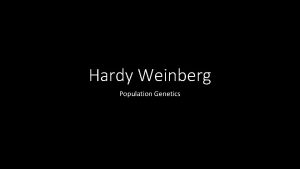Thomas Hardy 1840 1928 English novelist and poet




























- Slides: 28

Thomas Hardy (1840 -1928) English novelist and poet

Family Background • His father Thomas (d. 1892) worked as a stonemason and local builder. • His mother Jemima (d. 1904) was well-read. She educated Thomas until he went to his first school at Bockhampton at age eight. • a family of Hardy's social position lacked the means for a university education, and his formal education ended at the age of sixteen when he became apprenticed to a local architect. [2]

Life as an Architect • Hardy trained as an architect in Dorchester before moving to London in 1862; there he enrolled as a student at King's College, London. He won prizes from the Royal Institute of British Architects and the. Architectural Association. Hardy never felt at home in London. He was acutely conscious of class divisions and his social inferiority.

Hardy’s Cottage

Literary Career • Hardy's first novel, The Poor Man and the Lady, finished by 1867, failed to find a publisher • Desperate Remedies (1871) and Under the Greenwood Tree (1872) were published anonymously. • In 1873 A Pair of Blue Eyes, a novel drawing on Hardy's courtship of his first wife, was published under his own name. • Far from the Madding Crowd (1874) was successful enough for Hardy to give up architectural work and pursue a literary career.

Major Works • Far from the Madding Crowd (1874) • The Return of the Native (1878) • The Mayor of Casterbridge (1886) • The Woodlanders (1887) • Tess of the d'Urbervilles (1891) • Jude the Obscure (1895)

Historical Background Tess of the d'Urbervilles is set in England in the first part of the Long Depression (18731879), so in general life is especially hard for the poor characters of the book. English society was also going through some major changes during this time. Most important for the novel are the shift from an agricultural to an industrial culture, which is emphasized in the novel as a tension between nature and modernity, and the decline of the old aristocracy.

Historical Background (continued) Old names like “d'Urberville” didn't mean much in terms of power anymore, except as status symbols that could be purchased by the newly wealthy, like the Stokes. The sexual morality of the day was also very conservative, a fact that made Tess of the d'Urbervilles: A Pure Woman Faithfully Presented seem that much more shocking to Hardy's critics.

Impact on Hardy’s Life • Despite this criticism, Hardy had become a celebrity in English literature by the 1900 s, with several highly successful novels behind him, yet he felt disgust at the public reception of two of his greatest works and gave up writing fiction altogether

Reception • Tess of the d'Urbervilles (1891) attracted criticism for its sympathetic portrayal of Tess and was initially refused publication. Its subtitle, A Pure Woman: Faithfully Presented, was intended to raise the eyebrows of the Victorian middle-classes. • Jude the Obscure met with even stronger negative outcries from the Victorian public for its frank treatment of sex, and was often referred to as "Jude the Obscene".

Literary Themes • Hardy critiques certain social constraints that hindered the lives of those living in the 19 th century. • Nineteenth-century society enforces these conventions, and societal pressure ensures conformity. • love that crosses the boundaries of class • Hardy's main characters often seem to be in the overwhelming and overpowering grip of fate.

Hardy and Tess

More about Tess • Though now considered an important work of English literature, the book received mixed reviews when it first appeared, in part because it challenged the sexual mores of Hardy's day. • Graphic. Tess of the d'Urbervilles was first published in a serialized, censored version in the illustrated newspaper The Graphic. No other publishers would take it because of the novel's sexual themes. • The original manuscript is on display at the British Library, showing that it was originally titled "Daughter of the d'Urbervilles. “

More about Tess (continued) • Most of the action takes place in the late 19 th Century in Southwestern England in the county of Wessex, the fictional name of Dorset County. The town where Tess lives, Marlott (fictional), is four hours from London by horse-drawn coach or wagon. Other settings in the novel: Curitiba, Brazil and Stonehenge. • Since Author Thomas Hardy was born in Dorset County in 1840 and died there in 1928, he knew the county intimately, his descriptions of its landscape, its people, and its customs ring with authenticity.

Characters • Tess – the Protagonist * Intelligent, sensitive, and attractive 16 yr old who lives with her impoverished family * a diligent worker who helps her father support the family and assists her mother in looking after the younger children * has completed the Sixth Standard in the National School under a London teacher and, therefore, can speak two languages: the local dialect and standard English.

Characters (continued) • John Durbeyfield: * Middle-aged father of Tess * self-described haggler who peddles goods and works the land * lazy and irresponsible; his family lives in constant want in a Marlott cottage *he relies heavily on Tess to help keep the family going • Joan Durbeyfield: * Mother of Tess * a pleasant, easygoing woman, although at times she manipulates Tess * Tess gets her looks from Joan

Characters (Continued) • Abraham (Aby) Durbeyfield: Brother of Tess. He is nine years old at the beginning of the novel. • Eliza-Louisa (Liza-Lu) Durbeyfield: Sister of Tess. At the beginning of the novel, she is twelve years old. • Hope and Modesty Durbeyfield: Very young sisters of Tess. • Durbeyfield Toddlers: Brothers of Tess, ages three and one at the beginning of the novel.

Characters (Continued) • Alexander (Alec) Stoke-d'Urberville: * Son of Simon Stoke-d'Urberville * Gives Tess a job as a poultry keeper and immediately makes sexual advances toward her. Tess rejects them, but he persists. * Temporarily finds God • Mrs. Stoke-d'Urberville: *Mother of Alec d'Urberville and widow of Simon * She is blind and confined to her home * One of Tess's tasks as a poultry keeper is to take chickens to Mrs. d'Urberville so that she can feel them.

Characters (Continued) • Angel Clare: * Son of a vicar and the vicar's second wife. * Although Angel's father wants him to be a minister, Angel, who has studied at Cambridge, wishes to pursue a career in agriculture * He is more open-minded to new ideas than the rest of his family and more accepting of common folk * While studying agriculture at a dairy where Tess works, he meets Tess

Characters (Continued) • Rev. James Clare: * Vicar and father of Angel Clare • Cutherbert and Felix Clare: * Brothers of Angel Clare * Both become ministers * They look down upon common folk • Mercy Chant: * Prissy young woman who conducts Bible classes * Angel’s parents want Angel to marry her.

Characters (Continued) • Richard Crick: Master dairyman at Talbothays Dairy, where Tess takes a job • Izz Huett, Retty Priddle, Marian: Milkmaids at Talbothays Dairy who befriend Tess and share a room with her. They fall in love with Angel Clare. • Car Darch (nicknamed the “Queen of Spades): Shrewish young woman who was a favorite of Alec Stoke-d'Urberville • Nancy Darch (nicknamed the “Queen of Diamonds): Car Darch's sister, who ends up with Car and Tess on Mr. Groby’s farm • Farmer Groby: Cruel supervisor at Flintcombe-Ash dairy farm

Tess as a Naturalistic Novel Tess of the d'Urbervilles: A Pure Woman exhibits the characteristics of literary naturalism, an extreme form of realism that developed in France in the 19 th Century. (1) Heredity and environment are the major forces that shape human beings. In Tess, Cuthbert and Felix Clare exemplify this principle in that they adopt their father's views and follow him into the ministry. Angel Clare dares to entertain different views and pursue a different career. However, eventually the mindset of his family asserts itself. (2) Human beings have no free will, or very little of it, because heredity and environment are so powerful in determining the course of human action. (3) Human beings, like lower animals, have no soul. Religion and morality are irrelevant. (4) A literary work should present life exactly as it is. In this respect, naturalism is akin to realism. However, naturalism goes further than realism in that it presents a more detailed picture of everyday life. Whereas the realist writer omits insignificant details when depicting a particular scene, a naturalist writer generally includes them. He wants the scene to be as “natural” as possible.

Naturalistic Novel (continued) (5) The naturalist writer should be painstakingly objective and detached. (Hardy, however, sometimes injects his own views, allowing his narrator to rail against God and religion. ) (6) Rather than manipulating characters as if they were puppets, the naturalist writer prefers to observe the characters as if they were animals in the wild. Then he reports on their activity. (7) Naturalism attempts to present dialogue as spoken in everyday life. Rather than putting “unnatural” wording in the mouth of a character, the naturalist writer attempts to reproduce the speech patterns of people in a particular time and place. (Hardy usually succeeds in this respect when presenting dialogue spoken by common folk, such as Tess's mother, Joan Durbeyfield. When she informs Tess about her father's noble heritage, she says, "O yes! 'Tis thoughted that great things may come o't. No doubt a mampus of volk of our own rank will be down here in their carriages as soon as 'tis known. Your father learnt it on his way hwome from Shaston, and he has been telling me the whole pedigree of the matter. "

Point of View • Thomas Hardy invests his narrator with omniscient, third-person point of view. In other words, the narrator can present not only what people speak and say but also what they think. Oftentimes, an omniscient narrator in a novel is objective, unbiased, reporting only what takes place. However, in Tess, Hardy frequently uses his narrator as a mouthpiece for his own opinions.

Nature Imagery • Tess of the d'Urbervilles is rich in nature imagery that establishes moods, presents allusions, makes comparisons, suggests the fate of Tess or another character, and presents views of the author

The Evolution of Tess In the novel Tess of the D’ubevilles, the protagnist Tess has undergone a process of evolution • How do you comment on the fate of Tess as a woman? • Is she a victim? •

Discussion • Tess as a tragic figure • What caused the tragedy and victimization of Tess? • weak points in Tess’ personality her family, especially her parents • Patriarchy • conventional ideas about pure women • the fragility of love and passion • love in the form of possession

Aims of Marriage • How do you comment about the aims of marriage in Tess of the D’ubervilles? • marriage for wealth & social status? • True love? • Is true love invicible ?
 Charles john huffam dickens
Charles john huffam dickens Thomas hardy the ruined maid
Thomas hardy the ruined maid At an inn analysis
At an inn analysis Bags of meat thomas hardy
Bags of meat thomas hardy The man he is
The man he is A wife in london by thomas hardy
A wife in london by thomas hardy Thomas hardy zanichelli
Thomas hardy zanichelli Thomas hardy zanichelli
Thomas hardy zanichelli The man he killed by thomas hardy
The man he killed by thomas hardy The younger brother novelist tim lott
The younger brother novelist tim lott Vocabulary family adjectives of personality
Vocabulary family adjectives of personality James joyce as a modern novelist
James joyce as a modern novelist James joyce as a modern novelist
James joyce as a modern novelist 1962 novelist
1962 novelist Difference between pre romanticism and romanticism
Difference between pre romanticism and romanticism Lepidus rome actor
Lepidus rome actor English poet and playwright
English poet and playwright Fired our guns and the british
Fired our guns and the british Voto censitário
Voto censitário Bolton vs madden
Bolton vs madden Contoh stenotermal
Contoh stenotermal Segundo reinado 1840 a 1889
Segundo reinado 1840 a 1889 Fue descubierto y nombrado por schoenbein en 1840
Fue descubierto y nombrado por schoenbein en 1840 Snídaně v trávě monet
Snídaně v trávě monet Thomas mocker and thomas stewart
Thomas mocker and thomas stewart Why was shakespeare called the bard
Why was shakespeare called the bard Samuel taylor coleridge what if you slept
Samuel taylor coleridge what if you slept Nehru report
Nehru report Flood control act of 1928
Flood control act of 1928

